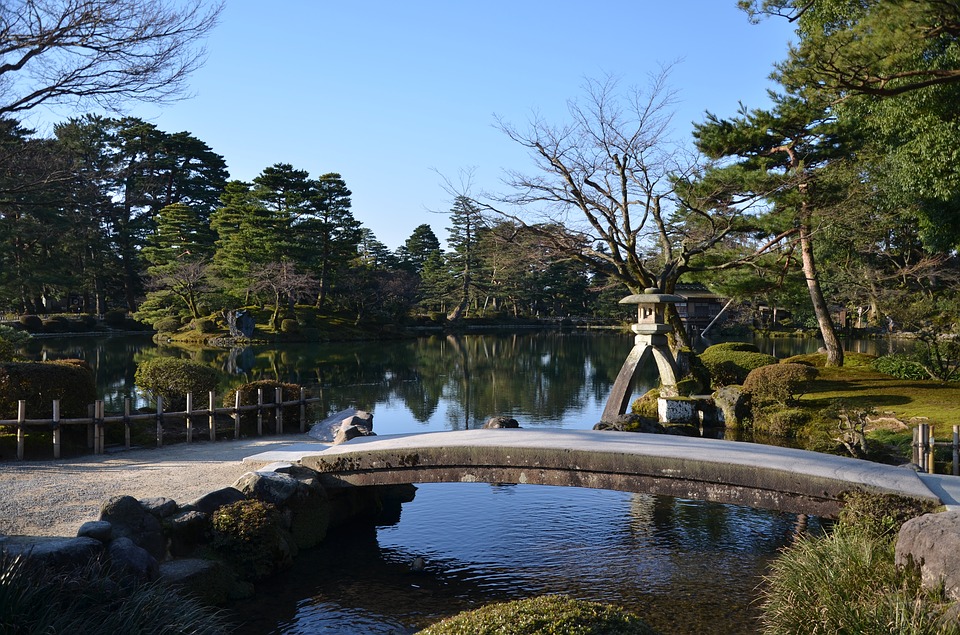Situated along the Sea of Japan coast of Honshu island, Ishikawa Prefecture is a prefecture in the Chubu region that is home to some of the best historical and cultural sites in the country.
Made up of 11 cities and several towns, its capital city is Kanazawa, a former castle town with a beautiful outer garden, the Kenrokuen, which is the most famous tourist spot in the region, and one of the country’s three most beautiful Japanese-style gardens, along with Kairakuen in Mito and Korakuen in Okayama.
How To Get to Ishikawa
To access Ishikawa Prefecture, you can fly, take the train, or ride a bus.
An international airport located in the city of Komatsu, Komatsu Airport is Hokuriku region’s largest airport and also serves Kanazawa and some parts of Ishikawa Prefecture. It operates multiple international and domestic flights a day, including routes to and from Shanghai via China Eastern Airlines, Taipei via EVA Air and Tigerair Taiwan, Seoul via Korea Air, Tokyo via All Nippon Airways and Japan Airlines, and Sendai and Fukuoka via Ibex Airlines.
There is another airport in the region, called Noto Airport, which is a domestic airport in the city of Wajima, on Ishikawa Prefecture’s Noto Peninsula. It only offers two routes — routes to and from Tokyo’s Haneda Airport via All Nippon Airways, and seasonal charter flights to and from Taipei via China Airlines.
Ishikawa is also served by many railway companies, such as JR West, which handles the Hokuriku Shinkansen Line, Hokuriku Main Line, and Nanao Line; Hokuriku Railway or Hokutetsu, which operates the Ishikawa Line and Asanokawa Line; Noto Railway Nanao Line; and IR Ishikawa Railway Line.
Various bus companies, such as Willer Express, offer highway buses that link Kanazawa and the rest of the prefecture to Tokyo, Yamagata, Sendai, Saitama, Takayama, and other cities. Visit the Willer Express website and Japan Bus Online website to look up routes, timetables, fares, and more.
Top Attractions in Ishikawa
Kanazawa
Kanazawa’s long history as a castle town makes it a fantastic place to visit if you are into Japanese history. The city has a castle, samurai and geisha districts, merchant areas, and more.
- Kenrokuen – Built in the early 1600s, Kenrokuen is a Japanese garden known for its vast collections of plants and trees. It has around 9,000 tree species and 200 plant species, which all look amazing any time of the year. It is also home to a tea house, a rest house, stone bridges, a pagoda, and the oldest fountain in Japan. Find out more about the garden, such as its opening hours, ticket prices, and access by visiting Kenrokuen’s official website.

- Kanazawa Castle – For about three centuries, Kanazawa Castle served as home to several feudal lords during the Edo Period. Its grounds include several watchtowers, gates, gardens, and buildings, and it is located right next to Kenrokuen. The Kanazawa Castle official website provides more information on tickets, opening hours, and others.
- Ninjadera – Also known as Myoryuji Temple, Ninjadera is a 16th century Buddhist temple famous for its many ninja contraptions, such as hidden tunnels, secret chambers, trapdoors, and concealed staircases. Myoryuji Temple’s official website provides more information on how to make a reservation to visit the temple.
- Higashi-chaya District – Kanazawa’s largest preserved chaya district, Higashi-chaya is made up of Edo Period buildings that are now cafes, tea houses, and shops that sell various gold leaf products and other local goods.
- Nagamachi District – During the Edo Period, Nagamachi was home to the residences of the samurai that served the ruling feudal lord. Today, these houses remain intact, and some of them have been turned into museums.
The most convenient way to access Kanazawa’s tourist spots is via the Kanazawa Loop Bus. There is a one-day pass that you can buy which only costs 500 yen. More information is available on the Kanazawa Loop Bus website.
Wajima
Wajima is a relatively new city in Ishikawa, only founded in 1954. It is situated on the coast of Sea of Japan.
- 1000 Rice Fields – Considered to be among the most spectacular sceneries in the prefecture, the 1000 Rice Fields are made up of 1004 actual rice fields that are owned and taken care of by the locals. From September to March, the fields are illuminated at night in memory of the magnitude-6.9 Noto earthquake in 2007.
- Wajima Taisai – A four-day festival held from August 22 to August 25 every year, Wajima Taisai features parades of beautifully adorned portable shrines and10-metre tall kiriko lanterns, accompanied by some lively traditional taiko drum beats. Around the venue, many stalls and shops sell local specialty foods and souvenirs.
Kaga Onsen
Situated not too far from Mount Hakusan, Kaga Onsen is composed of four onsen towns — Yamashiro Onsen, Yamanaka Onsen, Awazu Onsen, and Katayamazu Onsen — that are all more than 1,300 years old. It offers many public bathhouses, where people either on a day trip or staying for a night can soak in to relieve muscle pains and other illnesses.
In Awazu Onsen, there is an 8th century Buddhist temple, the Natadera, which is considered a holy site. It is tucked in a forested area on a hill, and its grounds include various buildings, walking trails, and caves.
From Kaga Onsen Station, which is along the JR Hokuriku Line, there are buses that can take you to the four onsen towns.
Noto Peninsula
Noto Peninsula is a charming area in Ishikawa with many gorgeous coastal sceneries to offer. It occupies the upper half of the prefecture, and is blessed with a tranquil, rural atmosphere.
- Myoyoji Temple – Founded in the early late 13th century, Myoyoji Temple is made up of several buildings, gardens, a five-storied pagoda, hiking trails, and gates, all sitting on top of a hill. It is accessible by bus from Hakui Station, along the JR Nanao Line. Myoyoji Temple’s official website has more information available.
- Kongo Coast – Extending about 14 kilometres, with incredible views of Sea of Japan and spectacular landscapes and formations, the Kongo Coast is often regarded as the most breathtaking part of the entire peninsula. It is known for its huge rocks, such as the Ganmon rock and the Hatago Iwa rocks, which have some Shinto-related significance.
Getting around Noto Peninsula is best done by rental cars, as buses depart once every hour or so, and do not go to all the sightseeing points.
Getting Around Ishikawa
There are multiple train lines that run within Ishikawa Prefecture, such as JR West’s Hokuriku Main and Nanao lines, Noto Railway’s Nanao line, IR Ishikawa Railway line, and Hokuriku Railway’s Asanokawa and Ishikawa lines.
Regular buses, tourist sightseeing buses, and taxis are also a common way to get around. More information is available on Ishikawa’s Official Tourism Travel Guide website.
Weather in Ishikawa
In the summer, Ishikawa is warm, with temperatures in the low 20s degrees Celsius, and rainy, most especially in September. Autumn and spring seasons in the region are pleasant, as the daily temperatures drop to about 10 to 15 degrees, with a few rainy days. In winter, daily average temperature varies from 0 to 5 degrees, and days are generally dry.
